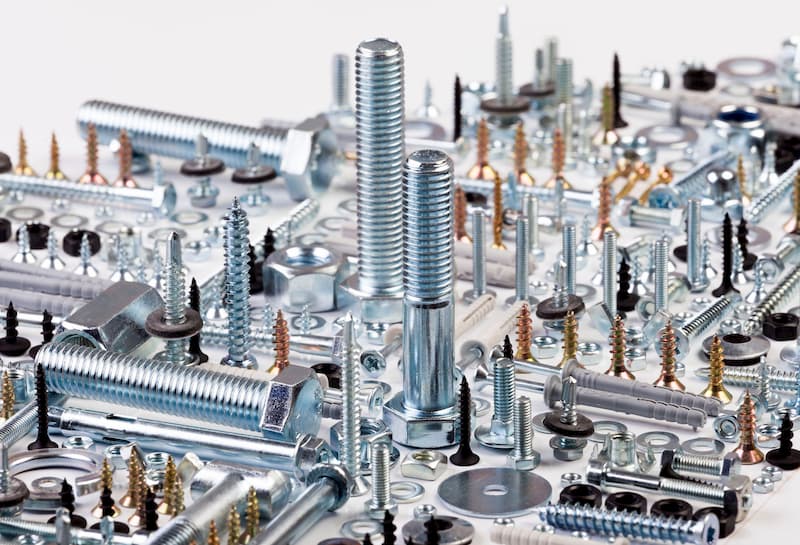Modern machinery is a marvel of engineering. Internal combustion engines of generators, for example, have controlled explosions taking place in the engine cylinders with rates up to 3600 rpm. That translates to 60 explosions per second in a two-stroke engine or 30 explosions per second in a four-stroke engine. And diesel generators usually work 24×7. As such, the machine must be capable of handling extreme forces for long periods.
Another thing to keep in mind during the product design phase is the ease of maintenance. Any machinery requires certain maintenance routines after specified running hours. The design must be such that engineers and technicians can access and dismantle as many parts as necessary to service, repair, or replace them. As a result, it is necessary to secure machinery components using non-permanent means.
The sometimes extreme forces combined with the necessary flexibility means that a high degree of variability is required from the different types of fasteners. Their sole purpose is holding machine parts in place against excess vibration, force and pressures while maintaining the possibility of easy disassembly in case of non-permanent fasteners.
Permanent vs Non-Permanent Fasteners
As the name suggests, fasteners may be broadly classified as permanent and non-permanent fasteners. For example, rivets and some types of couplings are permanent and cannot be removed and reused once in place.
Most other fasteners are non-permanent. The term “non-permanent” does not mean that the joint is weak. In fact, hydraulic studs and bolts (a type of non-permanent fastener) are used in some of the most intensive applications.
The term only refers to the fact that they allow the parts to be separated for maintenance/inspection purposes. But when they are in place, they hold steady under the most ruthless conditions provided they are tightened up to the recommended torque.
In this article, we shall learn about the different types of fasteners available for use.
Bolt Types
Bolts are the most common type of fasteners. These machine elements are usually used to hold two unthreaded components together. A bolt has external male threads on one end and a hexagonal head on the other.
The bolt is normally fastened with a nut on the other end. Sometimes, one of the parts has a threaded hole to replace the bolt and minimise the number of components.
There are many different types of bolts to choose from. Each type provides some trade-offs. Let’s take a look at some popular bolts types.
Hex-Head Bolts
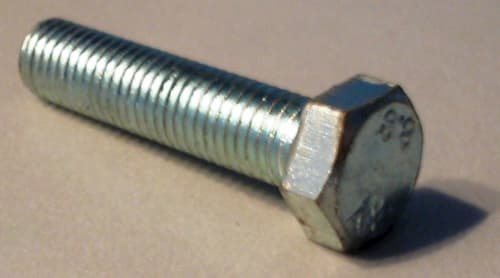
Hex head bolts have the bolt head in the shape of a hexagon and can be tightened easily using a wrench. The six sides offer a good granularity of angles to approach the bolt from. This is especially important for bolts fastened in difficult to reach spots.
Hex head bolts have machine threads extending halfway or all the way up to the bolt head. Partially threaded bolts deliver a higher shearing capacity. Hex head bolts are extensively used in machinery as they are easy to assemble and disassemble.
The tools needed are also quite commonly available. Regular spanners are affordable and easy to use. Socket set may be used to reach bolts in difficult to reach areas. A single adjustable wrench is all one needs to fasten or unfasten many different sizes of hex head bolts and nuts but this should not be made common practice.
Double End Bolts
This type of bolt resembles a simple threaded rod. The main difference between the two is that a double end bolt has a thread in both ends instead of having it for the whole length of the piece.
They can be used with a nut at one or both ends, with the other end mating with a hole that has a respective thread size.
Eye Bolts

Eye bolts have a thread at one end and a loop at the other end. The loop’s purpose depends on machine design and size.
For example, a few eye bolts can be used together to support the weight of the structure during lifting. Another possibility is using a series of eye bolts to direct wires or cables through them all.
Penta Bolt
Basically the same as a hex-head bolt with one distinctive difference – the head of the bolt has 5 sides. This means that the most common tools can not be used for fastening or unfastening these bolts.
That adds an extra layer of precautionary dimension, as anyone with a wrench cannot disassemble a structure.
Carriage Bolts
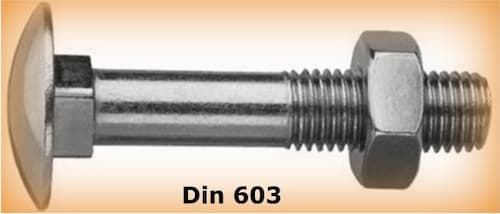
Carriage (or coach) bolts have a convex metal head followed by a square neck and thread. This type is mostly used to fasten wood elements. It is designed to fit its square neck into a wood piece through pressure. This feature gives carriage bolts the self-locking element.
The bolt is hammered gradually while securing the other side with a nut. This creates a pocket for the square neck in the wood, holding the bolt firmly in place.
Socket Head Bolts
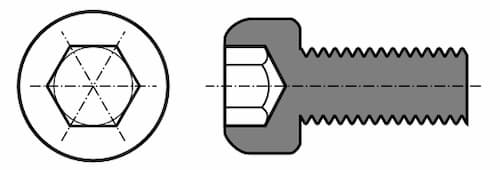
Also called Allen bolts, these types of fasteners typically have a cylindrical head with a hexagonal hole inside them. An Allen wrench or a hex socket tool can be used for tightening.
Other designs come with a domed button or a flat head countersunk head.
They require less space the method of tightening allows to have the head level with or below the surface of the material in case there are pre-drilled holes in the material.
U-Bolts
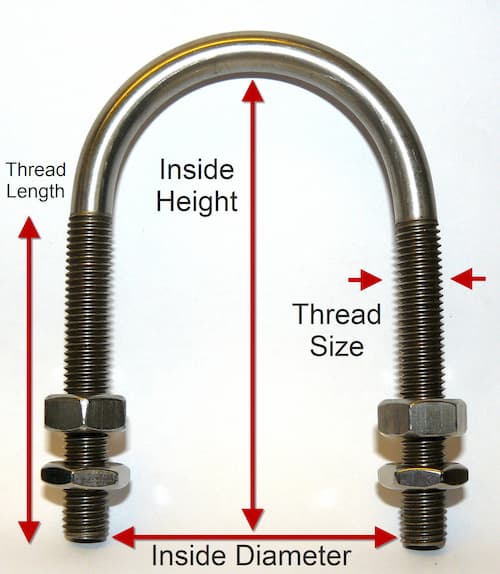
These bolts come in the shape of a horseshoe. While there is no thread on the bent section, the straight ends are usually threaded all the way.
U-bolts are excellent for securing the position of tubes and pipes or the position of other parts relative to tubes without making any holes in the tube itself.
There are many other variations of bolts available in the market. Some of them are:
- Flange
- Plow
- Shoulder
Screws
Screws have a structure similar to bolts. They have a male thread starting from the tip and the head can be of various shapes. However, there are some key differences between a bolt and a screw. While bolts can easily hold unthreaded objects together with a nut, a screw usually needs internal threads to maintain a grip.
Commonly, screws are self-threading (self-tapping), meaning that they create the thread into the material during installation. So no previous tapping is necessary.
Many different screw designs are in use. They all have specific pros and cons and the application will decide which one to select. Following is a list of the types of screws:
- Countersunk screw
- Deck screw
- Hex lag screw
- Self-drilling screw
- Machine screw
- Sheet metal screw
- Wood screw
We shall discuss some important screws that we need to be aware of as it is important to choose the right kind depending on the use.
- Personal account manager
- Quality assurance
- Payment terms for companies
- On-time delivery by Fractory
Self-Drilling Screws

Self-drilling screws, aka self-tapping screws, are screws that create an internal thread during installation. The defining feature of a self-drilling screw is the fully threaded shaft from tip to head. The material used for the screw is harder than the objects to be joined.
The screw tip is available in different shapes but generally, a small taper is provided with a notched tip so that the screw can easily create space for itself in the substrate while being turned.
Sheet Metal Screws
Sheet metal screws are used to join two metals together. They have a shank with the thread covering the entire length with a head on one end. The head may be flat or rounded.
The tip on sheet metal screws is extremely sharp to help it pierce the substrate and lodge itself into the material firmly. The thread is also made of hard material to ease the creation of the internal thread for the screw.
This screw is very versatile and is used for plastic and wood besides metal.
It comes in two types: self-drilling and self-tapping. The self-tapping screw only requires a hole in the object body. The internal threads are created during installation. The self-drilling screw comes with drilling tips.
Machine Screws

Machine screws are a type of screw used in most machinery today. It has a structure similar to the aforementioned screws and it also comes in a variety of head and tip shapes. Machinery screws also contain a Phillips or slotted socket on the head to tighten it into the substrate.
Typically, machine screws are installed into pre-drilled holes as opposed to creating the hole during installation. But some machine screws also have the ability to tap the hole during installation.
Nuts
A nut is a fastener with an internal thread. It is used in conjunction with a mating bolt of the same size. During the early stages, nuts (as well as bolt heads) were in the shape of a square. They were easier to manufacture by hand but they do not find much use today except in certain special scenarios.
The square nut provides a better grip and high torque than hex nuts to the user due to the increased length and surface area that the spanner comes in contact with when tightening or loosening the nut.
Hex nuts are the most common types of nuts due to them providing more ways of approach (6 instead of 4. Spanners are also usually offset at 15 degrees to increase the number of approaches from 6 to 12). This is especially required in spaces that restrict spanner movement or flat surfaces.
Nuts also come in various other designs such as wingnuts (for use without tools) and cage nuts for cramped spaces.
Cap Nuts
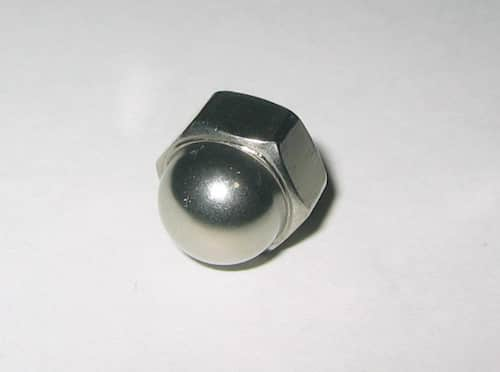
Also known as acorn or dome nuts, these nuts have a closed end in the shape of a dome. This ensures that the bolt-nut assembly is better protected from the environment and also provides a nice finish.
Castle Nuts
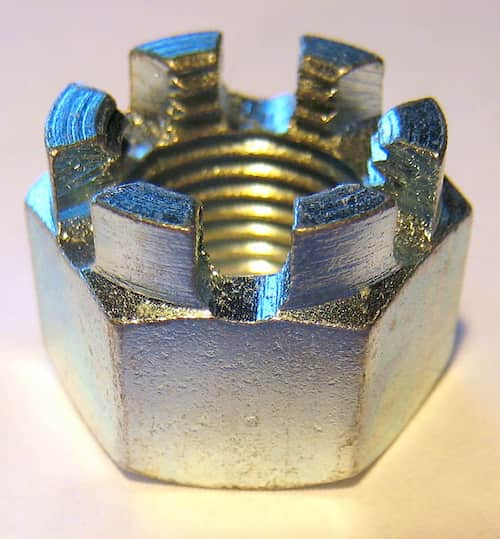
Castle, or castellated nuts have notches at one end. The design enables the insertion of a pin through the notches (the bolt also has to have a hole in it then) to fix the nut’s position.
They are suitable for situations where the torque requirements are low. For example, holding a simple ball-bearing in place may be an appropriate job for a castellated nut.
Weld Nuts
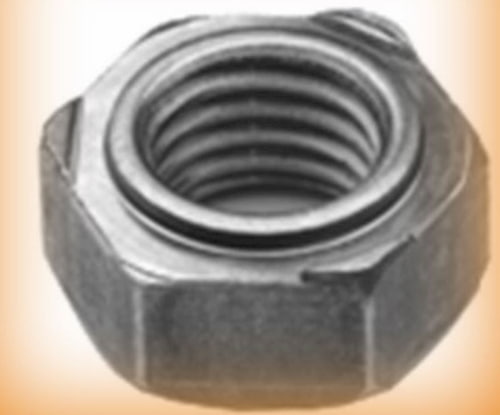
The name says it all – these nuts are welded onto the surface of a part. Welding helps to fasten parts in hard-to-reach places that could make a traditional bolt-and-nut assembly difficult.
Hex Nuts
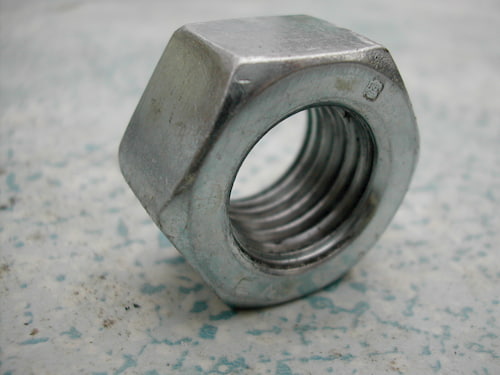
The most common of them all, these are cheap and easy to assemble with a wrench.
Nylon Lock Nuts
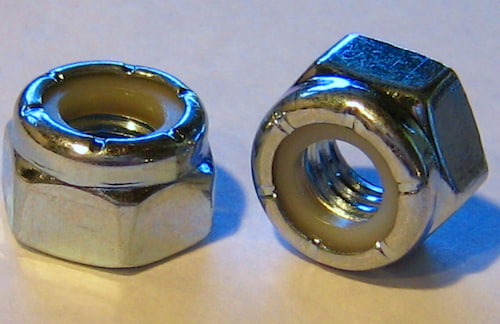
Nylon lock nuts are similar to hex nuts in their build but have an extra collar to accommodate a nylon ring. The ring pushes into the bolt’s thread to prevent loosening of the nut.
Rivet Nuts
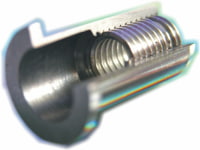
A great substitute for weld nuts in places where there is little room. The price can be greater but at the same time there is no need for extra operations in the form of welding.
Round rivet nuts may have the problem of sliding. Thus, the best option is to use hexagonal rivet nuts. Of course, the hole shape has to reflect the shape of the nut which rules out the possibility of simple drilling and replacing it with the need for laser cutting.
However, if the parts are laser cut anyway, the shape of the hole will almost not matter at all int he final costs.
Some other types of nuts include:
- Barrel nut
- Coupling nut
- Flange nut
- Slotted nut
- T-nut
- Wheel nuts
Washers
Washers are small, circular, metal discs in the shape of an annulus. They are a type of fastener that is normally used in conjunction with bolts and nuts. They are placed under nuts, joints or axle bearings. A washer serves multiple functions such as:
- Alleviation of friction.
- Even distribution of pressure from nut/bolt on the fastened component.
- Elimination of leakage
- Isolation of components.
- Prevention of loosening due to excess vibration.
Metals, as well as non-metals (plastic), are used as washer material. Washers come in many varieties and can be broadly classified into three major types:
Plain washers
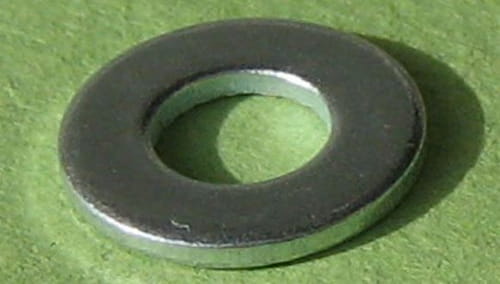
Plain washers are used to isolate the component being fastened from the nut/bolt being used for fastening. This may be for insulation purposes or to protect the surface of the substrate, especially in case the part has a paint coating.
Another important purpose of plain washers is to distribute the load by increasing the surface area that comes in contact with the substrate. If a hole is too big for a fastener, a plain washer can correct the size difference. Plain washers may be one of the following types:
- Flat washer. Made for general use. Used for even load distribution and diminishing hole size difference. Also known as Type A washer.
- Torque washer. Used in woodworking projects with carriage bolts to prevent the bolt from spinning while the nut is being fastened.
- Fender washer. Derives its name from the fact that it is used on car fenders. It has a small inner diameter and large outer diameter to distribute forces over a large area. Used especially with thin metals.
- C-washer. A C-washer has a section cut from a general-purpose flat washer. This washer is needed where the washer might have to be replaced without unscrewing the fastener all the way.
- Finishing washer. Designed for use with countersunk screws, it is also known as a countersunk washer.
Spring washers
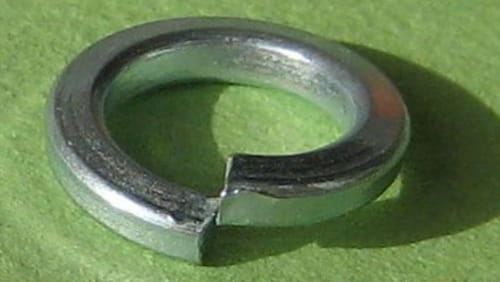
Spring washers act like springs due to the small modifications made in their circular shape. They develop axial flexibility which makes the joint more elastic. This ultimately averts unintended loosening or fastening of the fastener due to machine vibration. Spring washers come in many variations. Let’s discuss a few important ones.
- Belleville washer. This washer has the shape of a hollow cone with the top cut off. This gives the washer some flexibility in the axial direction. They can support axial forces with a small deflection. Belleville washers are used in applications that are prone to thermal expansion.
- Crescent washer. When a flat washer is slightly curved to give it the shape of a crescent, we get the crescent washer. Unlike a Belleville washer, a crescent washer can only support small axial forces. This washer is used to absorb small movements.
- Dome spring washer. Dome spring washer looks like a hollow cylinder connected to the base of a cone with the top lopped off. It acts similarly to a Belleville washer but is used when a flatter surface is needed.
- Wave spring washer. These washers have alternating bends in the axial direction that resemble a wave. Wave washers are less effective than Belleville washers. They are used as a cushion or a spacer for fasteners.
Locking washers

Locking washers lock the nut/bolt in place much better than spring washers. Lock washers are used where there is a chance of the fastener losing friction or undergoing rotation during operation. Some very effective lock washers are:
- External tooth lock washer. This washer has teeth that extend radially outward at a small angle. When the external washer is placed between the nut and the substrate and the nut is tightened, it bites into the bearing surface and holds the fastener in place. This washer is generally preferred when the substrate is a soft material such as plastic or aluminium.
- Internal tooth lock washer. This washer has teeth that extend radially inward. They bite into the fastener when it is tightened and prevent any relative motion. Besides, they also assist with absorbing shock and vibration.
- Split lock washer. Split washer looks similar to what you would get if you cut a flat washer from center to edge and bent the two ends in opposite directions. The two ends of the split washer lodge slightly into the mating surfaces when the fastener is tightened and hold it in place.
- Tab washer. A tab washer has a side tab that extends outward. Before tightening, this side tab is bent and placed against the nut to prevent relative motion.
Retaining Rings
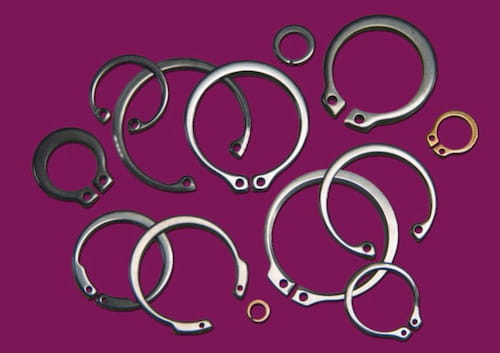
Retaining rings are metal fasteners used to hold a shaft or an assembly in place. They come in various designs.
Retaining rings are employed in many applications in machinery. One such instance is the retaining ring (circlip) used to hold the gudgeon pin of an IC engine piston in place. It is also used to hold the assembly together in a diesel generator’s high-pressure fuel pump.
Most retaining rings are used once and replaced when the machinery is overhauled but some may be reused. Retaining rings can be categorised into four major types. These types are further divided into sub-types. The four major categories are:
- Constant section retaining ring
- Tapered section retaining ring
- Spiral retaining ring
- Circular push-on
Rivets
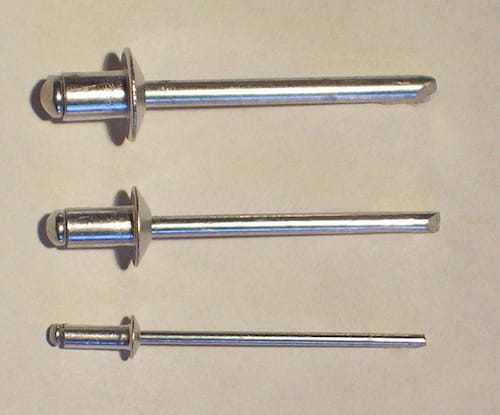
Rivets are permanent fasteners used to secure many different types of materials. They are lightweight and offer great support against shearing forces. The presence of a head at each end enables the rivet to support axial loads up to a certain extent. A special tool known as a rivet gun (or a riveter or a pop riveter) is used for installing rivets. Holes do not need threads when rivets are to be installed.
Unlike threaded fasteners, rivets create a permanent joint and cannot be removed and reused. Rivets offer an excellent strength-to-weight ratio. They are also easier to inspect (compared to welded joints). A visual check is sufficient for inspection (unlike in welding, where special tools are needed to inspect joint integrity).
These reasons have made the rivet the preferred fastener in the aerospace industry. They can create butt as well as lap joints. Some of the most common types are:
- Blind rivet
- Drive rivet
- Large flange rivet
- Semi-tubular rivet
- Tri-fold rivet
Anchors
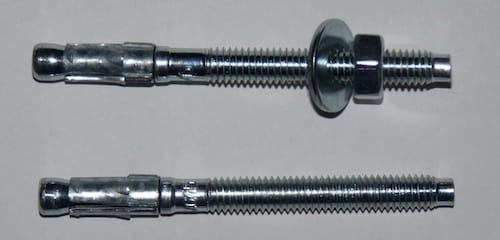
Anchors are a unique type of fastener used to secure metal to concrete or other materials such as epoxy, vinylester, and polyester resin. Some anchors are installed while the concrete is still drying while others are installed directly into hardened concrete.
Anchors are used to secure a variety of different objects and thus, they come in various designs. An anchor transfers tensile as well as shear force to the substrate. There are many types available in anchors. Some well-known anchor types are:
- Acoustical wedge anchor
- Bonded anchor
- Double expansion shield anchor
- Drop-in anchor
- Hammer drive pin anchor
- Plastic anchor
- Screw anchor
Inserts
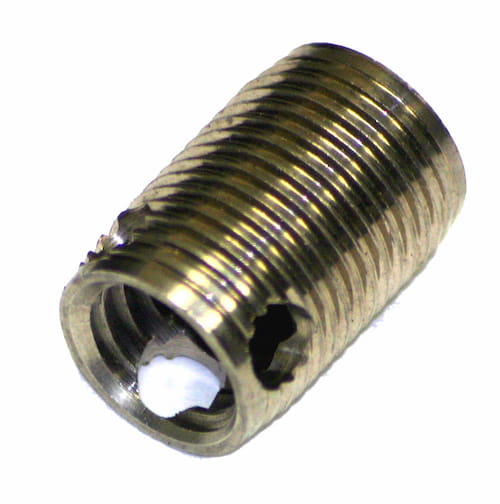
Inserts come in different forms. Their shapes can vary a lot as they perform a range of tasks in machinery as fasteners. Inserts are used for reinforcing joints, fixing eroded internal threads, used as keys in rotating machinery, or fastening anchor bolts to hanging pipelines.
Some inserts have internal as well as external threads. The external threads of the insert fit on to the original hole with the eroded thread in the substrate. A smaller sized stud or bolt is then mated with the internal thread of the insert for a tight grip.
Insert fastenings can be classified into the following groups:
- Dowel pin
- Threaded rod
- Unthreaded rod
- Helical threaded inserts
- Keys in shaft key-ways


